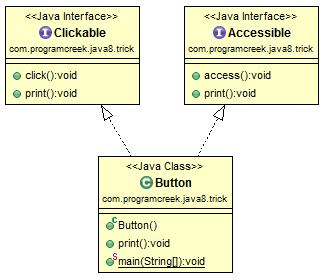From Wiki,
Multiple inheritance is a feature of some object-oriented computer programming languages in which an object or class can inherit characteristics and features from more than one parent object or parent class.
Default methods in Java 8 can be viewed as a form of multiple inheritance (except that attribute can not be inherited). Consider the example below, the Button class implements two interfaces – Clickable and Accessible.

Each interface defines a default method. The Button class therefore can call methods from both interfaces. This is like a multiple inheritance.
interface Clickable{ default void click(){ System.out.println("click"); } } interface Accessible{ default void access(){ System.out.println("access"); } } public class Button implements Clickable, Accessible { public static void main(String[] args) { Button button = new Button(); button.click(); button.access(); } } |
If both of the implemented interfaces define a default method with same method signature, then the implementation class does not know which default method to use. The implementation class should define explicitly specify which default method to use or define it’s own one. In the example below, Clickable and Accessible both define the print() method. In the Button class, the print() method specifies the default method.

interface Clickable{ default void click(){ System.out.println("click"); } default void print(){ System.out.println("Clickable"); } } interface Accessible{ default void access(){ System.out.println("access"); } default void print(){ System.out.println("Accessible"); } } public class Button implements Clickable, Accessible { public void print(){ Clickable.super.print(); Accessible.super.print(); } public static void main(String[] args) { Button button = new Button(); button.click(); button.access(); button.print(); } } |
The main motivation behind default methods is that if at some point we need to add a method to an existing interface, we can add a method without changing the existing implementation classes. In this way, the interface is still compatible with older versions. This is a cool feature. However, we should remember the motivation of using Default Methods and should keep the separation of interface and implementation.
To know more features of Java 8, check out Simple Java 8.
Alas, this doesn’t work. With code within interfaces, we do run into the diamond problem right away:
1. Create interfaces Accessible and Clickable and class Button like in the first example
2. Add
default void print() {...}to Clickable3. Add
button.print();tomain()(like in the second example)4. Try it – it runs fine, as expected
5. Add
default void print() {...}to Accessible6. Voilà – compile time error in class Button
Please accept my request. permission denied coming
oracle is dying to copy everything from scala to java , to keep java breathing.
Poor oracle
That’s horrible. It contradicts to definition of interface as OOD (and OOP) phenomena, wipes out I in SOLID and makes much other such “advances “
There are 3 scenarios that may arise because of same default method in 2 interfaces. read more about it here – http://netjs.blogspot.in/2015/05/interface-default-methods-in-java-8.html
Thanks for sharing the information! Default methods really made Selenium PageObjects a whole lot easier. See this post for examples: http://blog.jsdevel.me/2015/04/pageobjects-done-right-in-java-8.html
thanks for sharing this post… its really awesome
psd templates for websites